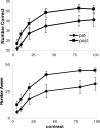Increased sensitivity after repeated stimulation of residual spatial channels in blindsight
- PMID: 17000999
- PMCID: PMC1595460
- DOI: 10.1073/pnas.0607073103
Increased sensitivity after repeated stimulation of residual spatial channels in blindsight
Abstract
Lesions of the occipital cortex result in areas of cortical blindness affecting the corresponding regions of the patient's visual field. The traditional view is that, aside from some spontaneous recovery in the first few months after the damage, when acute effects have subsided the areas of blindness are absolute and permanent. It has been found, however, that within such field defects some residual visual capacities may persist in the absence of acknowledged awareness by the subject (blindsight type 1) or impaired awareness (type 2). Neuronal pathways mediating blindsight have a specific and narrow spatial and temporal bandwidth. A group of cortically blind patients (n = 12) carried out a daily detection "training" task over a 3-month period, discriminating grating visual stimuli optimally configured for blindsight from homogeneous luminance-matched stimuli. No feedback was given during the training. Assessment of training was by psychophysical measurements carried out before and after training and included detection of a range of spatial frequencies (0.5-7 cycles per degree), contrast detection at 1 cycle per degree, clinical perimetry, and subjective estimates of visual field defect. The results show that repeated stimulation by appropriate visual stimuli can result in improvements in visual sensitivities in the very depths of the field defect.
Conflict of interest statement
The authors declare no conflict of interest.
Figures





References
-
- Sanders MD, Warrington EK, Marshall J, Weiskrantz L. Lancet. 1974;1:707–708. - PubMed
-
- Weiskrantz L, Warrington EK, Sanders MD, Marshall J. Brain. 1974;97:709–728. - PubMed
-
- Weiskrantz L. Blindsight: A Case Study and Implications. Vol 12. Oxford: Oxford Univ Press; 1986.
-
- Weiskrantz L. Prog Brain Res. 2004;144:229–241. - PubMed
Publication types
MeSH terms
LinkOut - more resources
Full Text Sources
Molecular Biology Databases

